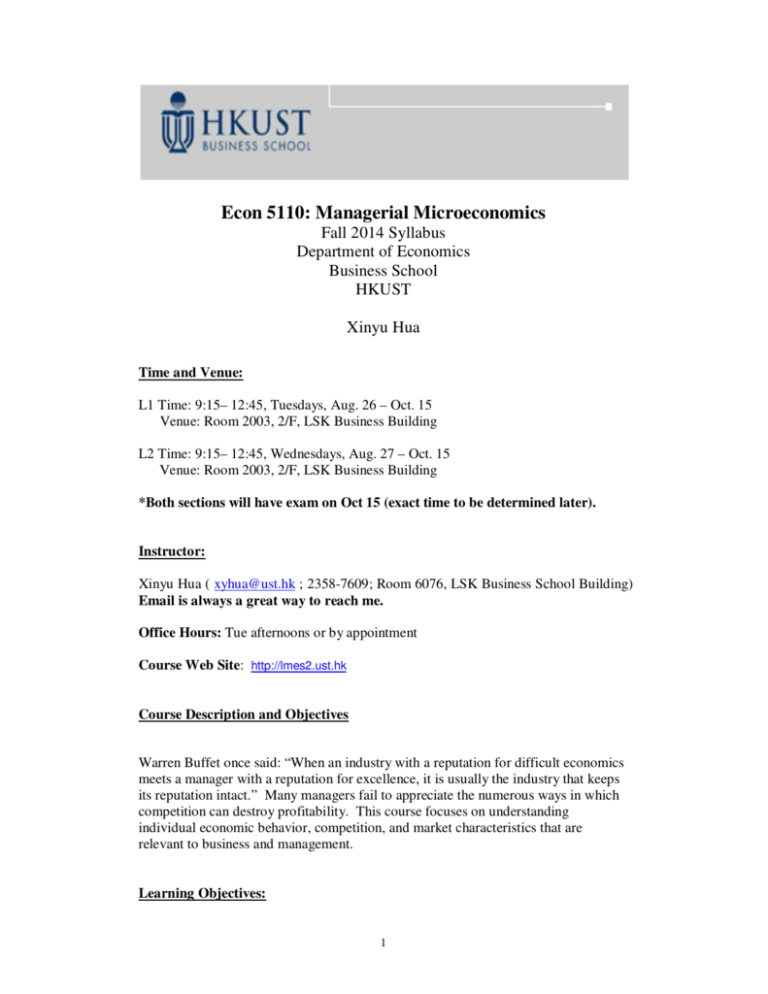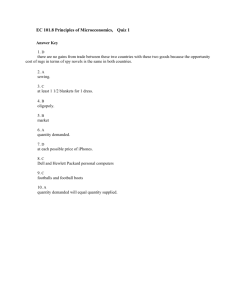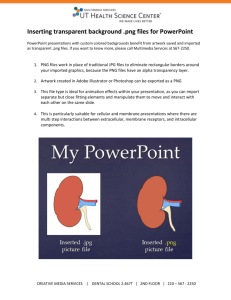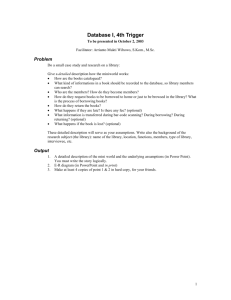
Econ 5110: Managerial Microeconomics
Fall 2014 Syllabus
Department of Economics
Business School
HKUST
Xinyu Hua
Time and Venue:
L1 Time: 9:15– 12:45, Tuesdays, Aug. 26 – Oct. 15
Venue: Room 2003, 2/F, LSK Business Building
L2 Time: 9:15– 12:45, Wednesdays, Aug. 27 – Oct. 15
Venue: Room 2003, 2/F, LSK Business Building
*Both sections will have exam on Oct 15 (exact time to be determined later).
Instructor:
Xinyu Hua ( xyhua@ust.hk ; 2358-7609; Room 6076, LSK Business School Building)
Email is always a great way to reach me.
Office Hours: Tue afternoons or by appointment
Course Web Site: http://lmes2.ust.hk
Course Description and Objectives
Warren Buffet once said: “When an industry with a reputation for difficult economics
meets a manager with a reputation for excellence, it is usually the industry that keeps
its reputation intact.” Many managers fail to appreciate the numerous ways in which
competition can destroy profitability. This course focuses on understanding
individual economic behavior, competition, and market characteristics that are
relevant to business and management.
Learning Objectives:
1
Understand and use tools, concepts, and theories from microeconomics in
performing demand and competitive analysis.
Apply demand and supply analysis in predicting market price and related
dynamics in competitive markets.
Understand the key trade-offs between high margin and high volume of sales in
pricing decisions, and choose different pricing strategies according to industry or
market conditions.
Predict competitors' actions and reactions using basic game theoretic methods. In
the context of oligopoly market, analyze the direct effect and the strategic effect
of a firm's decisions such as pricing, advertising, quantity, new product
introduction, quality, etc.
Brief Course Outline
The table below gives an approximate outline of the course.
Week 1
Introduction.
Market Demand
Topic
Required reading and preparation before class
Notes on Demand Estimation
Case on “Medicines Co.”
Week 2
Free/Easy Entry Market
--Demand and Supply Analysis
Group Assignment 1 due
Case on “Alusaf Hillside Project”
Week 3
Monopoly Market
--Pricing and Price Discrimination.
Case on “Saurer: The China Challenge”
Week 4
Oligopoly Market I: Competitive Advantage
Week 5
Oligopoly Market II: Game Theory (Competition and
Cooperation)
Group Assignment 2 due
Notes on “Industry and Firm Analysis”
Case on “Matching Dell” and “Dell 2009” (Pages 6-8 only)
Case on “Enterprise Rent-A-Car”
Case on “The Hawaiian Airline Industry, 2001-2008”
Mini Case on “Easyhome versus Macallian”
Week 6
Oligopoly Market III: Strategic Decisions
Group Assignment 3 due
Online Simulation on Universal Rental Car
Week 7
Oligopoly Market IV: Strategic Decisions with Asymmetric
Information
Case on “The Zero-Fee Tours in Hong Kong”
Week 8
Exam
Study Groups and Case Study Method
You are encouraged to follow the grouping made by the MBA office. The groups are
responsible for working on the cases and the group assignments.
The approach toward teaching and learning managerial economics is primarily
inductive. That is, you will learn many concepts and topics outlined above largely
through cases, examples and some simple models – this is the essence of the case
study method. The goal is to carefully study specific business situations and
decisions with the goal of extracting broader principles, which will then be available
to you in a wide variety of managerial contexts.
2
Good cases are necessarily complex and ambiguous. In preparing for case
discussions, you may find sorting through this complexity and ambiguity to be
frustrating. The problems presented in the case discussion may not have one correct
answer. However, there will generally be a set of insights and solutions which are
better than others. And it is in working through the messy details to find these
insights and solutions – both in your own preparation and in class discussion – that
the concepts and principles introduced in the readings and lectures will come alive
and be enriched for you.
For a case discussion to be a valuable learning experience, it is essential that you
come prepared to discuss the cases and readings assigned for that class. Finally, I
ask that you deal with the cases as you find them; do not seek outside or post-case
data on the firm or the industry.
How Will You Be Graded?
The grade is made up of five components:
1. Final Exam (50%): The final will be an in-class exam on Oct 15. It will be a
combination of a few mini-case questions.
2. One Group Written Assignment (5%): On Sep 2/3, All groups please submit a
supply curve constructed based on the case “Alusaf Hillside Project” and the excel
data provided. You can find the instruction on how to construct the supply curve on
the course site. There is no need to submit your answer for the other questions of the
case.
3. One Group Written Case Analysis (15%): On Sep 16/17, Some groups will
submit a report including competitive advantage identified based on the cases
“Matching Dell” and “Dell 2009 (pages 6-8 only)”, and the other groups will submit
the report based on the case “Enterprise Rent-A-Car”. The report should be in
PowerPoint format and has no more than 20 slides. During the class on Sep 16/17,
two groups will be selected to make 25-min presentation each.
4. One Group Simulation Project (15%): In Week 5, a URL will be sent to the
whole class. Each group should register before playing the simulation game. Please
finish the game by Sep. 29 (before 4pm). The detailed instructions will be distributed
later.
5. Class Participation and Contribution (15%): Attendance, preparation, and
participation are essential in this class, as in any class based on the case method.
Obviously, you can not participate if you are not present, so absences without
legitimate excuses will lead to a reduced participation grade. Learning opportunities
are maximized when students are actively engaged in discussion. Active engagement
means that you’re are listening carefully to the comments of other students and
seeking opportunities to make comments that move the class discussion forward.
Class participation will be evaluated primarily on (1) the effort and incentives to
prepare and to participate in class discussion, and (2) the evaluation of content:
3
• Relevance: Are your comments related to the case and to the comments of others?
• Advancement: Does your comment move the class discussion forward?
• Fact-Based: Have you used specific data from the case, from readings, or from
personal experience to support the assertions that you are making?
• Logical: Is your reasoning logical? Do you use economic concepts correctly?
What Materials Will We Use?
The key materials are the lecture notes, cases, and additional readings. Due to
copyright, you should not distribute these materials outside our class for any
education or business purpose.
Png: The textbook for reference is Managerial Economics, Asia-Pacific Edition, by
Ivan Png, 2005, Pearson, Prentice Hall.
BDSS: Another book for reference is The Economics of Strategy, 6th Edition, by
David Besanko, David Dranove, Mark Shanley, and Scott Schaefer, Wiley.
Additional notes, case preparation questions, and announcements will be posted in the
course website under “ECON 5110: Managerial Microeconomics.”
HKUST Academic Integrity and Honor Code
The HKUST Academic Integrity and Honor Code apply to this course. The complete
text of the Academic Integrity and Honor Code is available on the websites:
http://www.ust.hk/vpaao/integrity
http://www.ust.hk/vpaao/conduct/good_learning_experience.pps
Group Assignment
The assignment must be strictly your group’s original work. You may not discuss
these assignments with any person other than your group members. If your analysis
contains any information from outside sources, you must properly cite the sources.
Classroom Etiquette
Students are expected to arrive for class on time and the instructor will start and
end the class according to schedule. Students should demonstrate respect for the
instructor and fellow students during the class period. Please try to avoid side
conversations when your classmates raise questions or give comments.
You are welcome to bring your laptop or ipad to class in order to take notes or
perform calculations on your own computer. However, you may not engage in
distracting behavior such as using your laptop to surf the Web, to check e-mail, or to
do instant-messaging. For general guidelines about proper classroom behavior, please
consult: http://www.ust.hk/vpaao/conduct/good_learning_experience.pps
4
Course Outline (Details)
This detailed course structure is designed to help you organize what you learn into a
coherent framework for managerial microeconomics. However, it is important to
recognize upfront that this class can not be as perfectly organized as the outline
suggests. This is not accounting or statistics which begin with core, universally
accepted principles, and then build to harder problems and applications. Instead,
managerial economics is complicated throughout, and we may adjust the detailed
topics or learn new tools throughout the course to answer new questions that arise.
Optional Readings (Not Required):
Students who have not been exposed to microeconomics at all or would like to learn
more mathematical analysis are encouraged to read up on the following background
materials (notes available on the course website):
1. “A Note on Cost Functions and Cost Curves”;
2. “A Note on Demand Functions and Demand Curves”;
3. “A Note on Market Equilibrium and Competitive Market Equilibrium” ;
Weeks 1:
a)
Introduction
b)
Demand
Understanding Customer Value, Demand Curve, and Price Elasticity
Factors Affecting Demand
Demand Estimation (Customer Value Method)
Case:
Medicines Co. (HBS)
Reading:
Course Site: Notes on Demand Estimation
Png: Chapter 2, Chapter 3 (optional)
Weeks 2:
a)
Market Structure
Reading:
Png: Chapter 7 (pp.231-246) (optional)
b)
Free/Easy Entry Market
Firm’s Supply Decisions: Costs and Capacity
Demand-Supply Analysis
Case:
5
The Alusaf Hillside Project (HBS)
Reading:
Png: Chapter 4 (pp.105-121, pp.125-128), Chapter 5 (optional)
Week 3:
a)
Monopoly Market: Pricing
Pricing Methods
--Marginal Revenue and Marginal Costs (Excel)
--Value-based Pricing: e.g. Customer Value Model
--Cost-based Pricing: Markup and Price Cost Ratio
Reading:
Png: Chapter 8 (pp.267-277, 288-289) (optional)
b)
Monopoly Market: Price Discrimination
Direct Segment Price Discrimination
Indirect Segment Price Discrimination
Case:
Saurer: The China Challenge (A) (HBS)
Optional Case:
Tupelo Medical (Kellogg)
Reading:
Png: Chapter 9 (pp.313-323, 327-340) (optional)
Week 4:
a)
Oligopoly Market I: Competitive Advantage
Five Forces (Not to be discussed in class)
Four Types of Competitive Advantage:
--Market Power
--Niche Advantage
--Benefit Advantage
--Cost Advantage
Case and Group Presentation 1:
Matching Dell (HBS) and Dell 2009 (pages 6-8 only) (Ivey)
Case and Group Presentation 2:
Enterprise Rent-A-Car (Kellogg)
6
Reading:
Course Site: Notes on Industry and Firm Analysis
BDSS: Chapter 8 (pp.258-264) and Chapter 9 (optional)
Week 5:
a)
Oligopoly Market III: Game Theory (Competition and Cooperation)
Game theory
Nash Equilibrium
Simultaneous Games and Sequential Games
Cases:
The Hawaiian Airline Industry, 2001-2008 (Kellogg)
Easyhome versus Macallian (HKUST)
Reading:
Png: Chapter 10 (pp.349-357, 367-381) (optional)
Week 6:
a)
Oligopoly Market III: Strategic Decisions
Price, Quantity/Capacity, Advertising, New Product Introduction
Direct Effects and Strategic Effects
Tools:
Spreadsheets for Solving Oligopoly Price or Quantity Competition
Simulation:
Simulation on Universal Car Rental (HBS)
Reading:
BDSS: Chapter 5 (pp.180-192), Chapter 7 (Optional)
Week 7:
a)
Oligopoly Markets IV: Strategic Decisions With Asymmetric Information
Asymmetric Information and Quality
Case:
The Zero-Fee Tours in Hong Kong (HKU)
Reading:
Png: Chapter 12 (pp.431-442) (optional)
7








